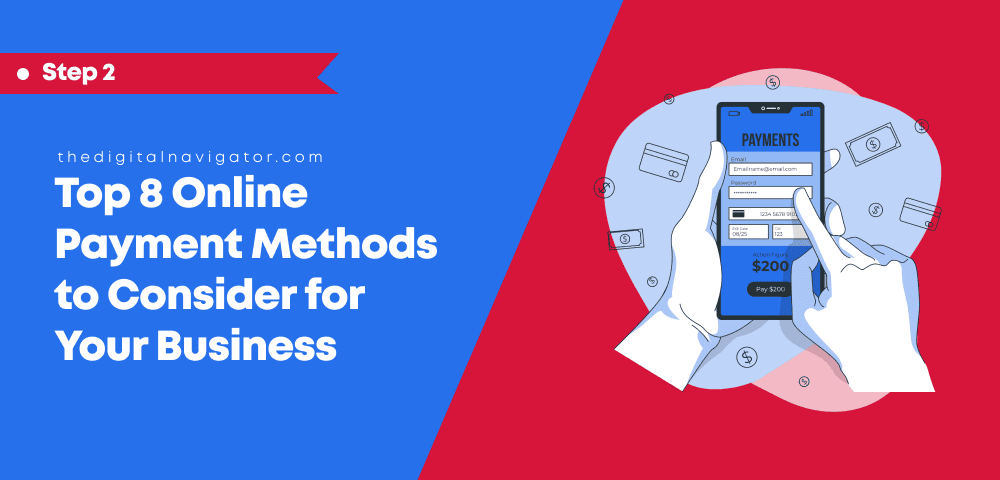Top 8 Online Payment Methods to Consider for Your Business
Published Date: |
Updated Date:
Here is our list of finalists for the top 8 online payment methods you can use to jumpstart your business. Inside, we list different payment methods for business, popular online payment methods, and all your customers’ payment methods for online shopping.
This article is Part 2 of 3 in our guide to Guide to Popular Online Payment Methods to Simplify Your Sales Process.
Step 3
What’s the difference between direct and third-party payment processing for my website?
Alright, time to talk about small business payment methods that work for almost anyone on the market today!
As we mentioned before, there are quite a few payment methods you can adopt to accept payments online, but having been in the business of online sales as long as we have, we have our favorites.
8 Online Payment Methods for Small Businesses | Popular Online Payment Methods
To help you make the right decision for your business and customers, here is a detailed breakdown of the best payment methods businesses use for all their online transactions:
- Stripe
- Apple Pay
- Dwolla
- Square
- PayPal
- Authorize.net
- Rotessa
- BrainTree
1. Stripe
Stripe is one of the most popular online payment solutions for small business that acts as an intermediary between buyers and sellers, and handles issues affiliated with credit card payments. Not only does it include data security, but also withdrawals and recurring payment options. It also includes the payment processing and payment gateway features you need.
Stripe also allows you to process refunds automatically, without having to take a ton of time out of your day to solve return of funds issues. This allows your business to be more productive as you don’t need to go back and forth making and receiving payments.
Best of all, it is a platform that is perfectly tailored for businesses who serve customers on a global scale, as it accepts payments in more than 155 international currencies and has a ton of yearly checks and balances for security compliance and QA.
For those concerned about security, Stripe is above the bar when it comes to encryption. They encrypt customer financial information, and stores the decryption codes separately, which means Stripe never has direct access to credit card numbers or other payment info.
Together, the efficiency and security features of Stripe make it our personal favorite when it comes to preferred payment methods. Some sources (and general customer consensus) even marks Stripe as one of PayPal’s top competitors in the market!
What sets Stripe apart from other online payment methods?
Not only is Stripe fairly simple to set up (particularly if you have a WordPress website) and customize, but you do have the option to create payment forms from scratch–though for this option we recommend getting the help of a professional.
They also give you the option to host payment processing directly on your website, though the third party option is available through them as well.
A quick look at Stripe metrics also shows that it has no monthly fees, unless you decide to opt-in to additional features like subscription services. You do however pay a relatively low per-transaction cost of 2.9% + $0.30.
Here are a few other reasons you might want to consider Stripe for small business payment methods:
- Built-in APIs and developer tools
- Access to mobile payments on the go
- Easily integrates with existing eCommerce platforms including BigCommerce, Shopify, WooCommerce, Magento, and Spree Commerce
- Simple reporting for transaction management
- Exceptional customer service response, with access to an agent in five minutes or less, 24/7
- Flexible payment options and management of website subscriptions–you can change up your billing preferences whenever you need to without canceling.
All that said, there are some drawbacks to using Stripe that we think are important to note before you commit. Not only do you likely need the help of a developer to customize checkout pages to match your brand, but you are entering into a high-risk industry.
Stripe also serves about 40 countries across the globe, which means there is a small chance your country of service may not be supported.
Finally, you may face some limitations for functionality when it comes to in-person payments, although with WooCommerce for example you can include a point of sale plug-in, or a Stripe card reader. If you do require in-person payments most of the time, then Square may be better suited to your needs.
2. Apple Pay
As you may have guessed from the name, Apple Pay is a contactless payment method for Apple devices such as iPhone, Apple Watch and Mac. It was designed as a modern replacement for physical wallets, and allows people to pay from their Apple devices instead of using a physical debit or credit card.
Apple Pay allows users from more than 60 countries to make payments with their iPhones in retail stores and online using an NFC chip built into their iPhones. This functionality is not unique to Apple Pay however, since most payment gateways like Stripe and Authorize.net are now Apple Pay inclusive.
Still, the convenience of paying for transactions using your Apple Pay account (whether in-person or online) does have its benefits. You don’t have to carry around a physical wallet, and can make payment sin just a few clicks thanks to Apple Pay having stored your financial information–and even your shipping information!
All payers need to do is verify their card information one time, and then they are free to make payments online. This is an incredibly convenient way to ensure that your customers are getting the payment support they need, without having to enter their information over and over again.
The main advantage of the Apple Pay method is simple, and is largely to do with security: The system generates a token of payment which reduces the chance that your credit card or debit card information is accessible to hackers.
Note however that while your information may be safe, the ease by which people can create fraudulent transactions using a customer’s phone can create problems for your customers in the future. Still, the feature is free to use for customers, which improves payment accessibility for your brand.
Some other considerations that should be made before choosing Apple Pay involve customer support and the ease by which you can add Apple Pay as an option through other payment accounts. Your customers can easily buy online, but there is no one for them to call if they’re having issues with making payments.
Stripe would – in this instance – be a slightly better option due to full-scale customer support that you don’t have to manage on your own.
3. Dwolla
While there are many different online payment methods, Dwolla is a lesser known, but still effective online payment method that markets itself as a white label service–which means it is a fully supported product made by one company, and sold by another.
The biggest advantage to using Dwolla is that your business can integrate with the ACH network, which means you can self-host your payments to send, receive, and facilitate bank-based transfers. That’s because Dwolla is meant to serve B2B organizations over peer-to-peer usability.
ACH payments are easier to accept because bank account numbers do not change often like that of credit card numbers. Moreover, once you have your payee’s account information, you can automate the ACH transfers which acts as a great type of online payment for recurring payments.
This is especially good news for those who need more than small business payment methods, where large companies can facilitate wide-scale payouts. Businesses can receive payments without having to open a merchant account, and rarely if ever have to bear the load of high transaction costs.
While Dwolla is similarly supported by platforms like WooCommerce, Shopify, Magento, and BigCommerce, it is more commonly used by businesses outside the US. Users do have customization options as well–though again there is some technical aptitude involved where a developer may come in handy.
However, there are some drawbacks to using Dwolla that might make you reconsider its efficacy for your business. Although it is quite a bit cheaper when compared to other B2B online payment methods, this is not a platform that is widely used by businesses and may reduce user trust in your product for that reason.
As well, there is no capability to add credit card transactions, and transactions take quite some time to process. Finally, it is likely that your customers will have to verify their banking details or provide full bank account numbers for purchases, which can create a lot of friction for smaller retailers or businesses who may want to purchase your services.
4. Square
Square is an incredibly popular online payment platform that helps businesses manage online AND in-person payments without too much hassle. It allows credit card processing and mobile payments, and retailers can even purchase a card-reader to improve payment mobility for storefront sales.
Square also has a reputation for helping small businesses boost their online sales presence and brand identities. They help online businesses set up everything – from eCommerce storefronts to email marketing, all to improve a business’ capacity to grow and scale.
There are no processing fees or monthly fees, and no merchant account provider sitting on those funds for verification. Basically, there is a lot less processing time needed to confirm payments, which reduces client and provider stress at every level of a transaction.
Finally, there is no application or approval process for Square, making it a great option for those who need basic payment functions without all the technicalities that come with getting approval.
All clients get three primary functions for free, including payments, POS software, and the capacity for online ordering.
Knowing of course that Square is similarly supported by WooCommerce, Magento, BigCommerce, and OpenCart, user reports dictate that WooCommerce and Shopify users do have trouble syncing products to the site. There is also a record of poor customer service, which many of our in-house experts can attest to.
To best summarize the advantages and disadvantages of Square’s online payment system, here is a quick pros and cons list for your review:
Pros:
- Great point of sale terminal – great for restaurants, new companies, small-transaction operations, and businesses that are on the go
- There is no monthly fee, and flat rate options are available
- Customers can pay using their phones
- There is a low barrier to entry, since new coaches, consultants, and businesses typically get accepted, and can get the card reader fast
- No contracts and very user friendly
- Accepts payments offline, and has a quick deposit processing time of about two days
- Works for high-risk industries (such as the cannabis industry) which other payment gateways do not support
Cons:
- Square is not ideal for large businesses with big transaction loads
- There is definitely something to be desired when it comes to customer support
- Large businesses who do want to use Square must pay higher-than-average fees per transaction
- Customization is somewhat limited
5. PayPal
PayPal is an ecommerce company that facilitates payments between parties through online transfers. It acts as a middleman between your bank and merchants, and keeps your payment information secure.
Getting started on PayPal is straightforward and easy. All you need to do is to link your bank account, credit or debit card to your PayPal account, and you can start using it to make and accept online purchases.
That’s the beauty of PayPal, which is a direct competitor to Stripe, for example. Not only can you use PayPal to transfer money to others with just an email address or phone number, but you can also make products in PayPal with a specific link. All your customer has to do is click the link and they can buy or send funds.
PayPal is admittedly an excellent online payment method for consultants, content providers, coaches, and many other types of business.
Businesses like yours can adopt PayPal, where customers will see the PayPal option in their checkout counter, and can click to swiftly create a transaction through whatever payment method they have connected to their own account.
Transactions are also super-speedy. You can get paid and withdraw those payments almost instantly–which means that as a small business payment method, your day-to-day operations can run a little faster, and more smoothly.
Depending on the eCommerce platform your site uses, you can use PayPal payment options for in-person transactions as well, even for credit and financing options pertaining to your products.
That said, PayPal’s flexibility when it comes to payment terms can also be confusing to some members.
There are a ton of options including paypal checkout, express checkout and more, and because each one is slightly different, it can get a little confusing when it comes time to choose which option is right for your products and business.
Of course, PayPal has been around the longest of these payment options, and it continues to be the safest way to pay online since neither the business nor the customer has to disclose any banking information or credit card details to make the purchase.
It’s all automatic through PayPal, who keeps your personal financial information safe behind closed doors.
In short, your money is super secure, customer privacy is protected, and with such a large customer base, transactions occur much faster than traditional small business payment methods (that require credit card entries or info about shipping).
Here are a few other reasons you should consider using PayPal when choosing online payment methods for your business:
- PayPal is easy to use and set up
- They have a wide range of customization options, and offer flexibility when creating different product and payment options for online shopping
- Fees are minimal, though they do occur per transaction
- Exchange rates are fair, so you can accept almost any currency on the market
- Businesses can create clickable payment links available throughout their website and sales funnels
- Invoice creation and delivery directly from your PayPal dashboard, including other money management tools
- Applicable with a variety of third party shopping cart programs
- Supported by platforms such as WooCommerce, Shopify, BigCommerce, Magento, and Spree Commerce
Of course, no online payment method is perfect, so it’s important to consider the following disadvantages before signing up to use PayPal for your business:
- Customers need to make a PayPal account before they can make a purchase
- You may have to discuss options with a sales team to get the best possible ROI
- You cannot modify payment terms and subscription options once you have created your accounts and products
- If payment plans or subscriptions for customers extend beyond 24 months, there is a chance that PayPal will randomly stop those options without notifying you
- Should any disputes arise, PayPal will favor the customer as opposed to the business
- There is a hefty fee for chargebacks, which can sometimes result in frozen assets
- Presence of integration issues where email entries must be exact, or certain transactions will be put on hold due to ‘suspicious’ activity–without telling you exactly why
- It can be difficult to get support from customer service, while some customers refuse to use PayPal altogether, which could lead to a loss of revenue
6. Authorize.net
Authorize.net is a payment gateway offered by Visa. This payment method’s job is to encrypt and securely authorize credit card transactions. Payment gateways like Authorize.net are required when accepting online payments because they are responsible for storing sensitive credit card data.
Authorize.net provides high risk businesses with essential tools to navigate eCommerce activities. In addition, it allows businesses to be flexible by accepting payments on their own terms. This lays the foundation for a more systematic high-risk payment processing.
Unlike traditional payment processing, Authorize.net also offers great speed and reliability making it one of the best online payment methods available for large scale businesses.
For instance, it’s high risk payment solution is an advanced processing technology that has the ability to approve transactions in no time, as well as dictate whether a payment has been approved or rejected.
This acts as a great usability feature for large businesses who are operating online. This is particularly important for businesses who expect to – or who are – targeted by a high amount of fraudulent transactions, since they can quickly reverse transactions if a card is found to be stolen.
Large scale businesses can also utilize Authorize.net at its maximum potential during the management of routing transactions, all without having to implement or install a software. Other tasks Authorize.Net can perform include transaction management, account setting configuration, report generation, and account statement viewing.
Given Authorize.net’s capacity for safe and secure payments for larger businesses, and because it is also supported by WooCommerce, Shopify, BigCommerce, Magento, and Volusion, it is a great option for those who require:
- Access to a merchant account for payments
- Support for credit cards and digital payments
- Increased fraud detection and prevention
- Monthly billing with no long-term contracts, or flat-rate pricing options
- Full access to customer support and services
Whereas it may not be the best options for businesses who:
- Do not want added expenses because they use alternate providers simultaneously
- Do not want to pay extra for added plugins or software licenses
- Do not want a complicated set up
- Wish to avoid per-transaction fees on every purchase
7. Rotessa
We are including Rotessa here because this is a hybrid option we use at The Digital Navigator, and which we offer our clients as well. It does only work in the US and Canada, which means you would need a bank account in that country, but the fees are extremely low, and you get the direct billing option straight to your existing website without a third party.
We believe this is a truly great option for those who have a high transaction value for their products, since they offer plans on a fixed fee system as opposed to a percentage of the fees you charge your own customers. That can save you tons of money in the long run.
Rotessa comes with a great user-facing dashboard that allows you to gain an understanding of all incoming and outgoing transactions in one place. So long as your customer has a bank account, you can get paid through Rotessa quite easily.
They also have a positive reputation for security and low per-transaction fees, plus you can send authorization requests to one or more emails at a time.
Add to that the ability to sync Rotessa with QuickBook and Xero integrations, and you’ll be all set to develop an online payment portal that serves all your accounting needs
8. Braintree
While Braintree is highly integratable with PayPal and other modern, small business payment methods like Venmo, it does stand alone as an online payment method that protects customers while offering a seamless and secure payment portal–that is almost totally customizable!
There are no fixed fees per month either, and provide a ton of compliance offerings that protect customers (and your business) against fraudulent transactions. In this way, Braintree improves user experience so that you don’t have to deal with cart abandonment.
In our view, Braintree is a great option for businesses who want something a little fuller than Stripe, or who want to diversify their risk by offering alternate gateway options should one go down.
Users can also accept payments in over 130 currencies across more than 45 countries, and can quickly and easily sell products through partner platforms–even local ones. Credit card pay
This article is Part 2 of 3 in our guide to Popular Online Payment Methods to Simplify Your Sales Process. Click to read Part Three: What’s the difference between direct and third-party payment processing? , or to review Part 1: What are Online Payment Gateways









0 Comments